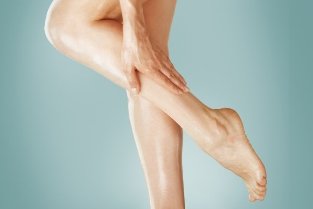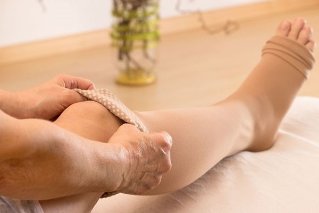Varicose veins - a disease associated with the increase of the deformation, as well as the formation of nodes in veins, near the surface of the body. Most often seen on the feet.

The disease is observed in 20% of women and 10% of men in the world. This disease, in the initial phases rarely worried sick, but it conceals a huge danger to the life, because at any moment can produce thrombophlebitis. Blood clots that form in varicose veins, can detach and moves with the flow of blood to the vital organs and become the cause of the death of the man.
Spider veins caused by the weakness of the wall and the valve system of the patient. In the standard, this system ensures the circulation of the blood in the veins of the legs to the heart, but in the case of malfunctions of the valves stasis of blood in the legs and an increase of the pressure. Eventually the veins become larger, the low, and their shape is disrupted.
Often, the varicose veins suffer people who have a genetic predisposition. In addition, the risk of developing this disease increases in people who are overweight, pregnant women, and in people who spend a lot of time standing. The main factor contributing to the development of the disease - the aging process of the body.
The symptoms
The disease occurs in two forms (primary and secondary).
The primary form of the disease is related to the weakness or violation of the venous wall. The factors that cause this disease are pregnancy, obesity, congenital weakness of the connective tissue, during a long stay in a vertical position, as well as the port of the bottom with the elastic stretched out.
The symptoms of a primary form of varicose veins:
- fatigue, heaviness, pain and burning in the legs;
- itching in the region of the vessels;
- swelling of the ankles or feet.
Secondary form of varicose veins occurs because of a rupture of the flow of venous, as well as trauma and tumors.
The symptoms of the disease in this form are the following:
- the swelling of the legs and calves after a long standing or sitting;
- the pain in legs and calves;
- of the skin, the changes (increase in drought, the change in color of the skin, decreasing the thickness of the skin);
- the night cramps in the legs;
- ulcers trophic.
The causes of varicose veins of the legs are:
- hereditary weakness of the vessels;
- a sedentary lifestyle;
- long static loads;
- hormonal disorders and hormonal drugs;
- the wounds to the legs;
- of pregnancy.
- the uprising of the severity of the overload;
- all.
In addition, in the risk group are:
- athletes, whose activities are related to an high load on the legs;
- the representatives of the professions, who spend a lot of time in a vertical position (hairdressers, teachers, servers, and other);
- those who work sitting down, and in particular the people who have the habit at this time to lay the legs;
- women who wear high heels;
- lovers of coffee and alcohol, because these products cause the dehydration of the body and thus thicken the blood.
If at the end of the working day appear mild swelling, and the person feels heaviness in the lower limbs, it might signal the beginning of varicose veins on the legs. Similarly, should alert periodic cramps and pain in the calves. And visible to the eye, the manifestations of varicose veins usually begin with the appearance of spider veins, after which there occur irreversible processes in the large veins.
Treatment

The therapy of the disease involves the application of drugs, aid to the state or to improve the tone of veins. Recommended to take vitamins (A, b,c, E) and minerals (magnesium, calcium, zinc, lecithin). Also for the treatment of varicose veins recommend the use of methods such as:
- micro-resonance therapy;
- EHF wave (therapy);
- magnet therapy;
- the laser therapy;
- acupuncture,
- underwent electro stimulation.
However, when the varicose veins spend sclerotherapy, or surgery. Sclerotherapy is an implementation of the injection of drugs, which leads to the invasion of varicose veins and the surgery is to remove scope of vienna.
But all the specialists strongly recommend to perform a simple prevention of the disease:
- avoid prolonged sun exposure, do not get involved in a hot tub and a sauna, as this reduces the tone of the veins and leads to a stagnation of blood in the legs;
- lead an active life, many move and do sports;
- monitor your diet and limit the amount of salt consumed;
- do not wear tight clothing, socks or tights with the elastic stretched, as this leads to compression of the veins;
- do not wear tight shoes and heels;
- do not throw the legs, do not stay long in sitting or standing position;
- take a shower;
- consume foods rich in fibre to avoid constipation, which has also resulted in the appearance of varicose veins;
- do daily self-massage of the feet;
- pass the centre of well-being and gymnastics, medical.
The pelvic varicose veins
Varicose veins of the small pelvis is a condition which occurs predominantly in women of childbearing age.
There are two variants of the evolution of the disease: the plethora of the pelvic region and a dilation of the veins of perineum and vulva. This separation is conventional, since more than half of the cases, the pelvic varicose veins perineum and the vulva causes disruption of the flow of blood in the veins of the small pelvis, and vice-versa.
Amorage the development of the disease is considered a pregnancy. Although the predisposition to this disease, it is possible to identify before the pregnancy by ULTRASOUND.
Depending on the severity of the disease specialist determines the method of treatment: conservative or operational. The pelvic varicose veins 1 or 2 degrees often apply methods of conservative therapy (e.g. curative physical education). And in the absence of effect of conservative treatment or the presence of 3 the extent of the disease, shows a surgical intervention.
























